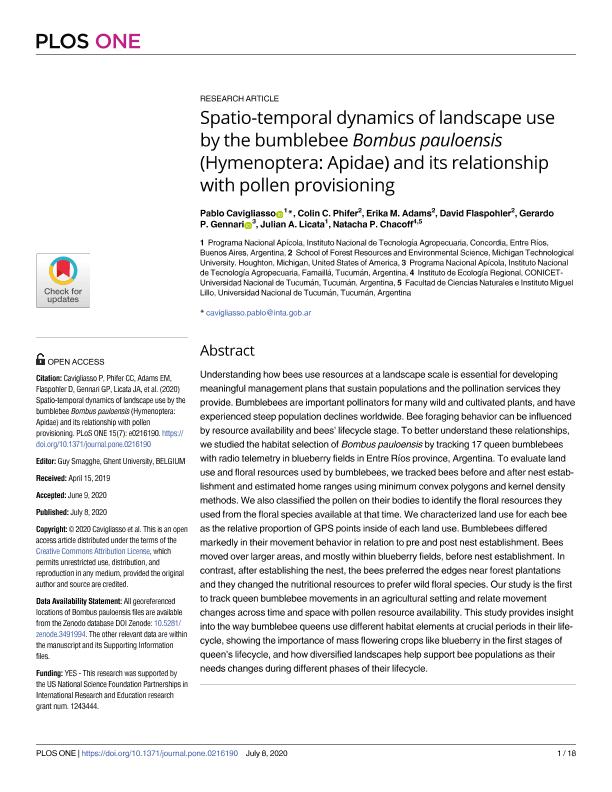Mostrar el registro sencillo del ítem
dc.contributor.author
Cavigliasso, Pablo

dc.contributor.author
Phifer, Colin C.
dc.contributor.author
Adams, Erika M.
dc.contributor.author
Flaspohler, David
dc.contributor.author
Gennari, Gerardo Pablo

dc.contributor.author
Licata, Julian Andres

dc.contributor.author
Chacoff, Natacha Paola

dc.date.available
2021-10-21T20:25:27Z
dc.date.issued
2020-07-08
dc.identifier.citation
Cavigliasso, Pablo; Phifer, Colin C.; Adams, Erika M.; Flaspohler, David; Gennari, Gerardo Pablo; et al.; Spatio-temporal dynamics of landscape use by the bumblebee Bombus pauloensis (Hymenoptera: Apidae) and its relationship with pollen provisioning; Public Library of Science; Plos One; 15; 7 July 2020; 8-7-2020; 1-18
dc.identifier.issn
1932-6203
dc.identifier.uri
http://hdl.handle.net/11336/144661
dc.description.abstract
Understanding how bees use resources at a landscape scale is essential for developing meaningful management plans that sustain populations and the pollination services they provide. Bumblebees are important pollinators for many wild and cultivated plants, and have experienced steep population declines worldwide. Bee foraging behavior can be influenced by resource availability and bees' lifecycle stage. To better understand these relationships, we studied the habitat selection of Bombus pauloensis by tracking 17 queen bumblebees with radio telemetry in blueberry fields in Entre Riós province, Argentina. To evaluate land use and floral resources used by bumblebees, we tracked bees before and after nest establishment and estimated home ranges using minimum convex polygons and kernel density methods. We also classified the pollen on their bodies to identify the floral resources they used from the floral species available at that time. We characterized land use for each bee as the relative proportion of GPS points inside of each land use. Bumblebees differed markedly in their movement behavior in relation to pre and post nest establishment. Bees moved over larger areas, and mostly within blueberry fields, before nest establishment. In contrast, after establishing the nest, the bees preferred the edges near forest plantations and they changed the nutritional resources to prefer wild floral species. Our study is the first to track queen bumblebee movements in an agricultural setting and relate movement changes across time and space with pollen resource availability. This study provides insight into the way bumblebee queens use different habitat elements at crucial periods in their lifecycle, showing the importance of mass flowering crops like blueberry in the first stages of queen's lifecycle, and how diversified landscapes help support bee populations as their needs changes during different phases of their lifecycle.
dc.format
application/pdf
dc.language.iso
eng
dc.publisher
Public Library of Science

dc.rights
info:eu-repo/semantics/openAccess
dc.rights.uri
https://creativecommons.org/licenses/by/2.5/ar/
dc.subject
CROP
dc.subject
MOVEMENT
dc.subject
BEES
dc.subject
BUMBLEBEES
dc.subject.classification
Ecología

dc.subject.classification
Ciencias Biológicas

dc.subject.classification
CIENCIAS NATURALES Y EXACTAS

dc.title
Spatio-temporal dynamics of landscape use by the bumblebee Bombus pauloensis (Hymenoptera: Apidae) and its relationship with pollen provisioning
dc.type
info:eu-repo/semantics/article
dc.type
info:ar-repo/semantics/artículo
dc.type
info:eu-repo/semantics/publishedVersion
dc.date.updated
2021-09-07T14:33:45Z
dc.journal.volume
15
dc.journal.number
7 July 2020
dc.journal.pagination
1-18
dc.journal.pais
Estados Unidos

dc.journal.ciudad
San Francisco
dc.description.fil
Fil: Cavigliasso, Pablo. Instituto Nacional de Tecnología Agropecuaria. Fundación Argeninta; Argentina
dc.description.fil
Fil: Phifer, Colin C.. Michigan Technological University; Estados Unidos
dc.description.fil
Fil: Adams, Erika M.. Michigan Technological University; Estados Unidos
dc.description.fil
Fil: Flaspohler, David. Michigan Technological University; Estados Unidos
dc.description.fil
Fil: Gennari, Gerardo Pablo. Instituto Nacional de Tecnología Agropecuaria. Fundación Argeninta; Argentina
dc.description.fil
Fil: Licata, Julian Andres. Instituto Nacional de Tecnología Agropecuaria. Fundación Argeninta; Argentina
dc.description.fil
Fil: Chacoff, Natacha Paola. Universidad Nacional de Tucumán. Instituto de Ecología Regional. Consejo Nacional de Investigaciones Científicas y Técnicas. Centro Científico Tecnológico Conicet - Tucumán. Instituto de Ecología Regional; Argentina
dc.journal.title
Plos One

dc.relation.alternativeid
info:eu-repo/semantics/altIdentifier/doi/http://dx.doi.org/10.1371/journal.pone.0216190
dc.relation.alternativeid
info:eu-repo/semantics/altIdentifier/url/https://journals.plos.org/plosone/article?id=10.1371/journal.pone.0216190
Archivos asociados
